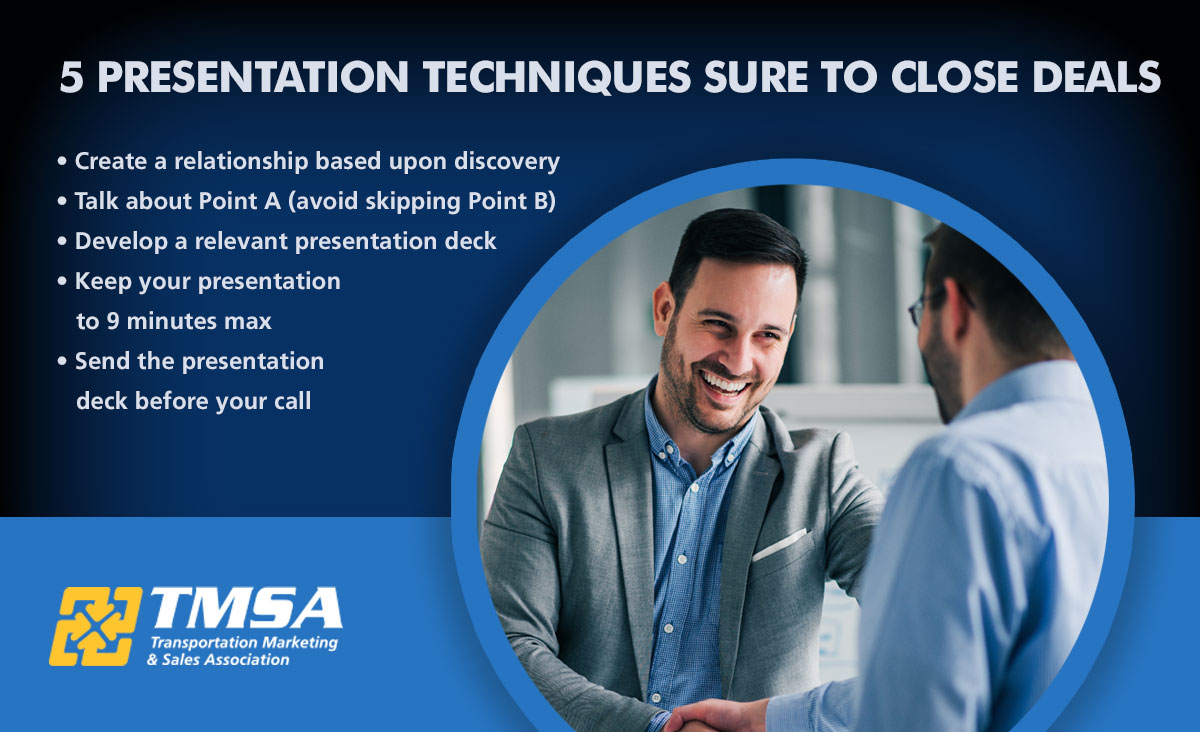
Written By: TMSA Staff | Mar 18, 2021 12:00:00 AM
The most successful sales reps in transportation and logistics know that when a presentation is done right, making a sales presentation with impact is a high-earning skill. So make sure to invest adequate time and energy to perfect your sales presentation techniques. Don’t lead with differentiators, lead to them. And be personable and conversational. Here are five sales techniques that will help you to successful close more deals quicker.
You may be tempted to stick to a positive and linear story during your sales discovery and presentation. That could involve everything from talking about benefits and outcomes to desired results. But that approach is a common mistake in sales.
Rather, before you discuss solutions and results you must understand the problems and pain points of your customer – whether it involves lack of capacity in particular lanes or freight rates that are too high. More importantly, you have to be sure your prospect not only has identified their challenges or problems but also readily admits to why they exist. Then, instead of telling your buyer what the problem is and how you’ll address it, you can get your buyer to connect with the problem on their own.
This technique is completely linked to the last one. Point A is the problem and Point B is the desired outcome. Point A is the problem your buyer will continue to face if they don’t make a change. Yet, many in sales focus on Point B (shiny outcomes) rather than focusing on the problem and helping the shipper to solve it.
Granted sometimes as the provider you have no real control over solving the problem – but here’s how you can stand out from your competitors. Switch the focus of your presentation to Point A. Talk frankly about a pain point is more effective than talking simply about outcomes (which oftentimes is what typical salespeople gravitate to). Focusing on Point A triggers loss aversion and the natural human reaction to loss aversion is a sense of urgency.
Simplicity is at the heart of every good business presentation. People don’t want a lot of info in one sitting – nor can they absorb a lot. Remember that “less is always more” and always include only relevant information that is beneficial for them to understand “what’s in it for me?”
In addition, make sure to use more graphics and fewer words. Buyers tend to be much more visual these days. And incorporate the unexpected by challenging the beliefs of your audience to wake them up and get them engaged quickly in the conversation.
According to HubSpot®, presentations for lost deals last an average of 11.4 minutes. Why does anything longer than this go poorly? Because humans don’t think well for that long. In today’s world of past-paced conversations, multi-tasking, and immediate access to information, we seem to have the attention of a fish. Our brains call a time out at the nine-minute mark. When you hit that point, you need to change channels in your buyer’s brain. You can do that by switching up who’s speaking in real life, or on a video or demo. That resets your clock to zero and you’ve got another nine more minutes for the next portion of the show. Ignore this rule and you’ll lose your buyer for good.
You might assume that sending a potential buyer your sales deck before a call is like revealing “whodunnit” on the cover of a murder mystery. The belief is that no one is going to pay attention to the rest of the book, right? Wrong.
If your presentation deck is compelling, the prospect will want to get into it with you – even if they know the main points made. Having your deck upfront will help to facilitate collaboration, and the two of you will ultimately dive in, dissect the good bits, talk through questions, and figure out solutions. Together. If the prospect has the gist of the information upfront, they will know it’s going to be a compelling conversation.
In addition, you can use this as an opportunity to test how interested they are in you as a provider and potentially how invested they are in the relationship. How? Start your conversation with something like: “Based upon the information in the deck I sent you, where should we start?” Don’t worry if they didn’t review it; they’ll just tell you to take it from the top. Nothing’s truly lost except their opportunity to jump more quickly into a deeper conversation.
This blog is sponsored by Landstar
Interested in learning more about becoming a Landstar Agent? Visit us for details.
Tags: Sales

By JP Wiggins, Co-Founder and Vice President of Logistics at 3Gtms, where he manages channels and partnerships for the company. As part of a natural evolution of their existing offerings, many...

"I'm looking completely differently at how my company goes to market and interacts with customers." "I'd like to be much more transparent with customers and prospects on how we do things. For...